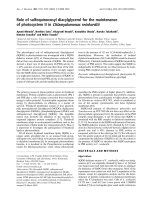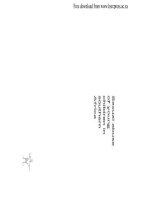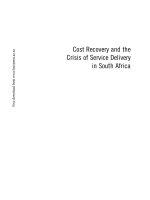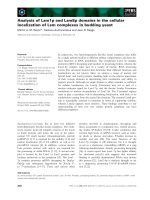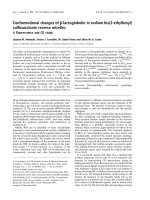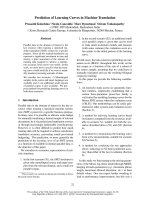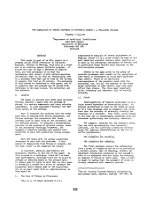West Bengal University of Technology BF-142, Salt Lake City, Kolkata-700064 Structure & Detailed Syllabus of B.Tech in Food Technology ppt
Bạn đang xem bản rút gọn của tài liệu. Xem và tải ngay bản đầy đủ của tài liệu tại đây (300.8 KB, 45 trang )
West Bengal University of Technology
BF-142, Salt Lake City, Kolkata-700064
Structure & Detailed Syllabus of B.Tech in Food Technology
1
2
ND
YEAR: 3
RD
SEMESTER (JULY-DEC)
A. THEORY:
A. THEORY
Contacts
(periods/week)
Credit
points
Code
Subjects
L T P Total
1. M-315 Mathematics 3 1 0 4 4
2. FT-301 Food Microbiology 3 1 0 4 4
3. FT-302 Bio Chemistry & Nutrition 3 1 0 4 4
4. FT-303 Process Calculations,
Thermodynamics & Food
Science
3 1 0 4 4
5. FT-304 Mechanical Design of Process
Equipment
3 1 0 4 4
Total of Theory
20 20
B. PRACTICAL:
B. PRACTICAL
Contacts
(periods/week)
Credit
points
Code
Subjects
L T P Total
1. FT-391 Food Microbiology Lab 0 0 6 6 2
2. FT-392 Bio Chemistry Lab 0 0 6 6 2
3. FT-393 Process Equipment Drawing 0 0 4 4 2
Total of Practical 16 6
Total of 3
rd
Semester
36 26
West Bengal University of Technology
BF-142, Salt Lake City, Kolkata-700064
Structure & Detailed Syllabus of B.Tech in Food Technology
2
2
ND
YEAR: 4
TH
SEMESTER (JAN-JUNE)
A. THEORY:
A. THEORY
Contacts
(periods/week)
Credit
points
Code
Subjects
L T P Total
1. FT-401 Chemistry of Food 3 1 0 4 4
2. FT-402 Principles of Food Preservation 3 1 0 4 4
3. FT-403 Food Process Technology-I
(Cereals, Fruits, Vegetables
&Beverages)
3 1 0 4 4
4. CHE-414 Unit Operations of Chemical
Engineering – I
3 1 0 4 4
5. CS-415 Data Structure & Algorithm 3 1 0 4 4
Total of Theory
20 20
B. PRACTICAL:
B. PRACTICAL
Contacts
(periods/week)
Credit
points
Code
Subjects
L T P Total
1. FT-491 Chemistry of Food Lab 0 0 6 6 2
2. CHE-484 Unit Operation Lab-I 0 0 3 3 2
3. CS-485 Data Structure & Algorithm Lab 0 0 3 3 2
Total of Practical
12 6
C. SESSIONAL:
C. SESSIONAL
Contact
(periods/week)
Credit
points
Code
Subjects
L T P Total
HU-481 Report Writing & Technical
Language Practice Lab
0 0 3 3 2
3 2
Total of 4
th
Semester
35 28
West Bengal University of Technology
BF-142, Salt Lake City, Kolkata-700064
Structure & Detailed Syllabus of B.Tech in Food Technology
3
3
RD
YEAR: 5
TH
SEMESTER (JULY-DEC)
A. THEORY
Contacts
(periods/week)
Credit
points
Code
Subjects
L T P Total
1. FT 501 Food Process Technology II
(Fish, Meat & Poultry)
3 1 0 4 4
2. FT 502 Food Process Technology III
(Dairy products)
3 1 0 4 4
3. FT 503 Food Process Engineering 3 1 0 4 4
4. FT 504 Waste Management of Food
Industries
3 1 0 4 4
5. CHE 514 Unit Operations of Chemical
Engineering II
3 1 0 4 4
Total of Theory
20 20
B. PRACTICAL
Contacts
(periods/week)
Credit
points
Code
Subjects
L T P Total
1. FT 591 Food Processing Lab I 0 0 6 6 4
2. FT 592 Food Analysis & Quality Control
Lab I
0 0 6 6 4
Total of Practical
12 8
Total of 5
th
Semester
32 28
West Bengal University of Technology
BF-142, Salt Lake City, Kolkata-700064
Structure & Detailed Syllabus of B.Tech in Food Technology
4
3
RD
YEAR: 6
TH
SEMESTER (JAN-JUNE)
A. THEORY
Contacts
(periods/week)
Credit
points
Code
Subjects
L T P Total
1. FT 601 Food Process Technology IV
(Fats & Oils)
3 0 0 3 3
2. FT 602 Advanced Food Microbiology
& Biotechnology
3 1 0 4 4
3. FT 603 Bakery, Confectionary and
Extruded foods
3 0 0 3 3
4. FT 604 Food Process Equipment
Design
3 0 0 3 3
5. ET 601 Process Instrumentation and
Control
3 1 0 4 4
Total of Theory
17 17
B. PRACTICAL
Contacts
(periods/week)
Credit
points
Code
Subjects
L T P Total
1. FT 691 Food Processing Lab II 0 0 6 6 4
2. FT 692 Food Analysis and Quality
Control Lab II
0 0 6 6 4
3 FT 693 Food Biotechnology Lab 0 0 3 3 2
4 FT694 Seminar 0 0 3 3 2
Total of Practical
18 12
Total of 6
th
Semester
35 29
West Bengal University of Technology
BF-142, Salt Lake City, Kolkata-700064
Structure & Detailed Syllabus of B.Tech in Food Technology
5
4TH YEAR: 7
TH
SEMESTER (JULY-DEC)
A. THEORY
Contacts
(periods/week)
Credit
points
Code
Subjects
L T P Total
1. FT 701 Food Packaging Technology 3 0 0 3 3
2. FT 702 Food Additives and Post
Process Handling
3 0 0 3 3
3. FT703
(A/B/C/D
)
Elective I (Subject) 3 0 0 3 3
4. HU 701 Industrial Management 3 0 0 3 3
5. HU 702 Engineering Economics 3 0 0 3 3
Total of Theory
15 15
B. SESSIONALS
Contacts
(periods/week)
Credit
points
Code
Subjects
L T P Total
1. FT 791 Project 0 0 12 12 8
2. FT 792 Report & Presentation on
Practical Training
- - - - 3
3 FT 793 Seminar 0 0 3 3 2
Total of Practical
15 13
Total of 7
th
Semester
30 28
West Bengal University of Technology
BF-142, Salt Lake City, Kolkata-700064
Structure & Detailed Syllabus of B.Tech in Food Technology
6
4TH YEAR: 8
TH
SEMESTER (JAN-JUNE)
A. THEORY
Contacts
(periods/week)
Credit
points
Code
Subjects
L T P Total
1. FT 801 Food Plant Layout & Design 3 0 0 3 3
2. FT 802
(A/B/C/D)
Elective II (Subject) 3 0 0 3 3
3. ID 801 Ethics and IPR 2 0 0 2 2
4. ID 802
(A/B/C/D)
Elective III (Interdisciplinary) 3 0 0 3 3
Total of Theory
11 11
B. SESSIONALS
Contacts
(periods/week)
Credit
points
Code
Subjects
L T P Total
1. FT 891 Project 0 0 18 18 12
2. FT 892 Project Defence - - - - 4
3 FT 893 Comprehensive Viva Voce - - - - 8
Total of Practical
18 24
Total of 8
th
Semester
29 35
Elective I (Subject) Elective II (Subject) Elective III
(Inter-disciplinary)
FT 703A: Enzyme
Technology
FT 802A: Plant Maintenance,
Safety & Hygiene
ID 802A: Marketing and
Distribution
Logistic
FT 703B:
Fermented
Food Products
FT 802B:
Principles of
Biochemical
Engineering
ID 802B:
Food
informatics
FT 703C: Utilization of
Food Industry
Wastes
FT 802C: Modeling and
Simulation of Food
Processes
ID 802C: Quality Control
and
Management
FT 703D: Entrepreneurship
Development
for Food
Technologists
FT 802D: Protein Technology ID 802D: Renewable
Energy
Technology
West Bengal University of Technology
BF-142, Salt Lake City, Kolkata-700064
Structure & Detailed Syllabus of B.Tech in Food Technology
7
DETAILED SYLLABUS
SEMESTER – III
M 315 : Mathematics – III
L-T-P = 3-1-0
At least 45 hrs/Sem
Module I : 10L
Fourier Series :
Introduction; Euler’s formula; problem of general Fourier series; conditions for
Fourier expansion; functions having points of discontinuity; change of interval; Even and odd
functional half range series; typical waveforms (square, saw-toothed, triangular, half wave
rectifier, full wave rectifier).
Module II : 10L
Series solution of differential equations and special functions : Introduction, validity of series
solution of an equation, general method to solve equation type : P
0
y”+P
1
y’+P
2
y=0; problems;
Bessel’s equation; properties of Bessel’s function; equation reducible to Bessel’s equation;
Legendre’s equation, Legendre function, recurrence formula for Legendre function,
orthogonality.
Module III : 10L
Partial differential equations and its applications : Introduction, linear and nonlinear equation
of first order; examples; homogeneous linear equations with constant coefficients; nonlinear
equation of second order, Separation of variables, formulation and solution of wave
equation; one dimensional heat flow equation and solution; two dimensional heat flow
equation and solution.
Module IV : 10L
Statistics : Mean, median, mode; standard deviation, variance, random variable; discrete
and continuous probability distributions : distribution and density function, mathematical
expectancy; standard probability models — Binomials, Poisson and Normal; Correlation and
regression; curve fitting — least square method.
Revision : 5L
Text Books / References :
1. Advanced Engineering Mathematics : E. Kreyszig, Wily, 5th Edn.
2. Higher Engineering Mathematics : B. S. Grewal, 1977
3. Jordon & Smith, Mathematical techniques, OUP
4. Fundamental Concepts of Mathematical Statistics : Gupta and Kapoor, S. Chand
5. Statistical Methods : N. G. Das
West Bengal University of Technology
BF-142, Salt Lake City, Kolkata-700064
Structure & Detailed Syllabus of B.Tech in Food Technology
8
6. Elements of partial Differential Equation : Sneddon, MGH
FT 301 : Food Microbiology
L-T-P = 3-1-0
At least 45 hrs/Sem
Module I : 10L
Introduction – definition, historical development and significance of food microbiology;
Microscope; Classification & morphology of microbes; Techniques of pure culture;
Bacteriology of air & water; Anti-microbial agents – physical & chemical – mechanism &
action.
Module II : 10L
Disinfection & disinfectants; Energy metabolism of aerobic & anaerobic microbes; Thermal
inactivation of microbes; Concept, determination & importance of TDT, F, Z & D values;
Factors affecting heat resistance; Pasteurization and sterilization.
Module III : 10L
Microbiology of milk & milk products like cheese, butter, ice-cream, milk powder;
Microbiology of meat, fish, poultry & egg and their products.
Module IV : 10L
Microbiology of fruits & vegetable and products like jam, jelly, sauce, juice; Microbiology of
cereal & cereal products like bread, biscuits, confectionary;
Revision : 5L
Text Books / References :
1. Essentials of Microbiology; K. S. Bilgrami; CBS Publishers, Delhi
2. Food Microbiology; WC Frazier; Tata McGraw Hill, Delhi
3. Modern Food Microbiology; James M Jay; CBS Publishers, Delhi
4. Microbiology; Pelczar, Chan and Krieg; Tata McGraw Hill, Delhi
5. Basic Food Microbiology; Bannett, Chapman and Hall
6. Food Microbiology; M. R. Adams
7. Hand Book of Microbiology; Bisen
West Bengal University of Technology
BF-142, Salt Lake City, Kolkata-700064
Structure & Detailed Syllabus of B.Tech in Food Technology
9
FT 302 : Biochemistry & Nutrition
L-T-P = 3-1-0
At least 45 hrs/Sem
Module I : 10L
Introduction to Biochemistry. Proteins and protein structures; Essential amino acids.
Metabolism of proteins (digestion and absorption); Nitrogen balance & nitrogen pool;
Evaluation of quality of proteins,
Module II : 10L
Enzymes; Definition, function, classification, nomenclature & structure; Co-enzymes and its
function; Mechanism of enzyme action, enzyme kinetics & environmental effects; Enzyme
inhibition.
Module III : 10L
Carbohydrates; Definition & classification; General chemistry of carbohydrates; Metabolic
pathways for breakdown of carbohydrates: glycolytic pathway, pentose phosphate
pathway, citric acid cycle, electron transport chain, ATP balance, gluconeogenesis; General
chemistry of lipids; Essential fatty acids; Digestion & absorption of lipids.
Module IV : 10L
Vitamins & minerals: occurrence, physiological function of vitamins and minerals.
Introduction to human nutrition; Nutritive values of foods; Basal metabolic rate; Techniques
for assessment of human nutrition,
Dietary requirements and deficiency diseases of different nutrients
Revision : 5L
Text Books / References :
1. Lehninger, Nelson & Cox, Principle of Biochemistry, CBS Publication
2. Modern Experimental Biochemistry, Boyer, Pearson Education
3. Lubert stryer, Biochemistry, Freeman & Co, N.Y.
4. Voet & Voet, Fundamentals of Biochemistry, Jonh Willey & Sons
5. Hames, B. D. (Ed), Biochemistry, Viva Books
6. Essentials of Food and Nutrition, Swaminathan, Vol 1 & 2
7. Fundamentals of Food and Nutrition by Sumati. R. Muldambi
8. Nutrition and dietetics by Rose
9. Nutrition and dietetics by Joshi
West Bengal University of Technology
BF-142, Salt Lake City, Kolkata-700064
Structure & Detailed Syllabus of B.Tech in Food Technology
10
FT 303 : Process Calculations, Thermodynamics & Food Science
L-T-P = 3-1-0
At least 45 hrs/Sem
Module I : 10L
Process Calculations, Material & Energy Balances : Mathematical requisites – use of log-log
and semi-log graph papers, triangular diagram, graphical differentiation and graphical
integration. Material balance without & with chemical reaction. Energy balance: enthalpy
changes, heat of reaction and its temperature dependence, heats of solution and mixing,
adiabatic flame temperature, use of psychometric charts.
Module II : 10L
Thermodynamics
Basic Concepts : The Ideal Gas; Review of first and second laws of thermodynamics; PVT
behavior of pure substances; Virial equation of state; Application of the virial equations;
Cubic equations of state; Generalized correlations for gases and liquids.
Vapour /Liquid, Liquid/Liquid, Solid/Liquid and Solid/Vapour Equilibria : Nature of
equilibrium; Phase Rule; Duhem’s theorem; Simple model’s for vapour/liquid equilibrium;
Rault’s Law; Henry’s Law; Modified Rault’s Law; K-value correlations; VLE from Cubic
Equations of State; Equilibrium and Stability; Liquid/liquid equilibrium; Solid/liquid
equilibrium, Solid/vapour equilibrium.
Module III : 10L
Application of Thermodynamics : Chemical Potential and Phase Equilibria; Fugacity and
fugacity coefficient for pure species and solution; Generalized correlations for fugacity; the
Ideal Solution; Property changes and heat effects of mixing processes.
The Vapour-Compression Cycle; the choice of refrigerant; Absorption, Refrigeration and
liquefaction: Low temperature cycle: Linde and Claude.
Module IV : 10L
Food Science :
Introduction & definition of Food Science; Palatability of food and measurement of
acceptance by :I)testing ii)appearance iii)smell iv)test; General structure and composition of
cereals like wheat & rice, nutritive value & various products like whole wheat flour, maida,
puffed rice etc; Food additives; classification, composition and nutritive value of fruits &
vegetables; Milk & milk products; Classification & properties of sugar; fats, oil & nuts; Spice &
beverages & their roles.
Revision : 5L
Text Books / References:
1. Chemical Process Principles (Part one and two), Hougen, Watson & Ragatz, Asian
Student Edition, Asia Publishing House
2. Basic Principles and Calculations in Chemical Engineering, Himmelblau, Prentice Hall
(I) 6th Ed.
West Bengal University of Technology
BF-142, Salt Lake City, Kolkata-700064
Structure & Detailed Syllabus of B.Tech in Food Technology
11
3. Coulson & Richardson’s Chemical Engineering – Volume 3 (Chemical and
Biochemical Reactors and Process Controls) ed. Richardson, J.F., Peacock, D.G., First
Indian ed. Asian Books Pvt. Ltd. 1998
4. Levenspiel, O., Chemical Reaction Engineering, Willey Eastern Ltd.
5. Smith & Vanness, Thermodynamics for Chemical Engineers, MGH
6. Food Science by Potter
7. Principles of Food Science Vol. I by Fennema, Karrel
8. Food Science by Mudambi
FT 304 : Mechanical Design of Process Equipment
L-T-P = 3-1-0
At least 45 hrs/Sem
Module I : 10L
Material of construction : Introduction to material selection; Material properties;
Environmental effects on material selection; Mechanical properties & strength of materials.
Design basis : Design code; Design pressure; Design temperature; Design stress & factor of
safety; Design & actual thickness; Corrosion allowance; Weld joint efficiency factor; Design
loadings; Criteria of failure.
Module II : 10L
Design of thin walled process vessels : Cylindrical & spherical vessels under internal and
external pressure; Design of attachments and closures; Compensation for openings; Design
of flange connections & threaded fasteners; Design of supports.
Module III : 10L
Design of thick walled high pressure vessels; Design of piping; Methods of fabrication of
ferrous & non-ferrous metals; Concrete, wood and other non-metallic construction.
Module IV : 10L
Design of belt and chain drives; Toothed gearing; shafting & bearing; specification of
handling equipment.
Revision : 5L
Text Books / References :
1. Introduction to Chemical Equipment Design — Mechanical Aspects;
B. C. Bhattacharya; CBS Publishers, Delhi
2. Process Equipment Design; H. C. Hesse and J. H. Rushton; Van Nostrand, East West
Press
3. Selection of Material and Fabrication for Chemical Process Equipment;
B. C. Bhattacharya; Chem. Engg. Education Dev. Centre; I.I.T Madras
4. Process Equipment Design; L. E. Brownell and E. H. Young; John Wiley and Sons,
Inc. N.Y.
West Bengal University of Technology
BF-142, Salt Lake City, Kolkata-700064
Structure & Detailed Syllabus of B.Tech in Food Technology
12
5. Computer Aided Design of Chemical Process Equipment; B. C. Bhattacharya; and C.
M. Narayanan; New Central Book Agency, Kolkata
6. Mechanical Design and Fabrication of Process Equipment; B. C. Bhattacharya;
Khanna Publishers, Delhi
FT 391 : Food Microbiology Lab
L-T-P = 0-0-6
1. Study of a compound microscope.
2. Gram Staining and Study of morphology of bacterial cells.
3. Study of autoclave, Preparation and sterilization of nutrient broth and agar.
4. Subculturing of a bacterial strain in liquid and solid medium.
5. Study of growth of E.coli by a spectrophotometer.
6. Study of microbiological quality of milk by MBRT test.
7. Preparation of synthetic medium for yeast and mould and inoculation with standard
strains of yeasts and moulds.
8. Isolation of starch-hydrolyzing organism from soil.
9. Dilution and Plating by spread –plate and pour –plate techniques.
10. Isolation of pure culture.
11. Estimation of microbial count of air.
FT 392 : Bio-chemistry Lab
L-T-P = 0-0-6
1. Separation of amino acids/sugars by Ascending Paper Chromatography.
2. Separation of sugars/amino acids by Thin Layer Chromatography.
3. Separation and isolation of proteins/amino acids by Paper Electrophoresis.
4. Determination of BOD
5
and COD of a sample of waste water.
5. Preparation of cell-free extract: Bacterial cell by sonication, Chicken liver by
homogenization.
6. Assay of enzyme activity — (a) Phosphatase assay [Chicken liver] (b) Protease assay
7. Study of an enzymatic reaction.
FT 393 : Process Equipment Drawing
L-T-P = 0-0-4
Mechanical design and drawing of process equipment : Storage vessels, Pressure Vessels,
Reactors, Heat exchanger, evaporator, distillation and fractionation column, agitators, filters.
West Bengal University of Technology
BF-142, Salt Lake City, Kolkata-700064
Structure & Detailed Syllabus of B.Tech in Food Technology
13
SEMESTER - IV
FT 401 : Chemistry of Food
L-T-P = 3-1-0
At least 45 hrs/Sem
Module I : 10L
Introduction to different food groups and importance of food chemistry; Water in foods and
its properties.
Carbohydrate :
Sources of food carbohydrates; Physico-chemical and functional properties; chemistry and
structure of homosachharides and heterosachharides.
Module II : 10L
Proteins : Sources and physico-chemical and functional properties; Purification of proteins;
Common food proteins.
Module III : 10L
Fats : Sources and physico chemical and functional properties; PUFA [Poly-unsaturated Fatty
Acids] hydrogenation and rancidity; Saponification number, iodine value, Reichert-Meissl
number, Polenske value; Lipids of biological importance like cholesterol and phospholipids.
Module IV : 10L
Minerals and Vitamins : Sources and structures of minerals & vitamins; Effect of processing
and storage of vitamins; Pro vitamins A & D; Vitamins as antioxidants.
Food Pigments & Flavouring Agents : Importance, types and sources of pigments — their
changes during processing & storages.
Revision : 5L
Text Books / References :
1. Essentials of Food & Nutrition by Swaminathan, Vol. 1 & 2
2. Food Chemistry by L. H. Muyer
3. Hand Book of Analysis of fruits & vegetables by S. Ranganna
West Bengal University of Technology
BF-142, Salt Lake City, Kolkata-700064
Structure & Detailed Syllabus of B.Tech in Food Technology
14
4. Food Chemistry by Linhinger
5. Chemical changes in food during processing by Richardson
6. Nutrition and Dietetics by Rose
FT 402 : Principles of Food Preservation
L-T-P = 3-1-0
At least 45 hrs/Sem
Module I : 10L
Objectives and techniques of food preservation; Canning: classification of cans, can
specification, structure of cans, lacquering, canning of food items, Thermal process time
calculations for canned foods, spoilage in canned foods.
Module II : 10L
Water activity of food and its significance in food preservation; dehydration and drying of
food items; IMF; Low temperature preservation: cold storage and freezing including
cryogenic freezing.
Module III : 10L
Preservation by fermentation: curing and pickling; Hurdle technology.
Module IV : 10L
Ionization radiation; Use of preservative in foods: chemical preservative, biopreservative
including antibiotics.
Revision : 5L
Text Books / References :
1. Technology of Food Preservation by Desrosier
2. Food Science by Potter
3. Fruits and vegetable processing by Cruss
4. Preservation of Fruits & Vegetables by IRRI
FT 403 : Food Process Technology – I
L-T-P = 3-1-0
(Cereals, Fruits, Vegetables & Beverages)
At least 45 hrs/Sem
West Bengal University of Technology
BF-142, Salt Lake City, Kolkata-700064
Structure & Detailed Syllabus of B.Tech in Food Technology
15
Module I : 10L
Storage of cereals, Infestation control; Drying of grains, Processing of rice and rice products.
Milling of wheat and production of wheat products, including flour and semolina.
Module II : 10L
Milling of corn, barley, oat, coarse grains including sorghum, ragi and millets; Processing of
tea, coffee and cocoa.
Module III : 10L
Storage and handling of fresh fruits and vegetables, Preservation of fruits and vegetable by
heat treatment. Production and preservation of fruits and vegetable juices, preservation of
fruit juice by hurdle technology. Preparation of Jam, Jelly and marmalade, pickles, vinegar
and tomato product.
Module IV : 10L
Non-alcoholic beverages; Food Laws, food rules and standards, Statistical Quality Control ;
Various types of packaging.
Revision : 5L
Text Books / References :
1. Food Science by Potter
2. Technology of Food Preservation by Desrosier
3. Principles of Food Science, Vol-I by Fennma Karrel
4. Preservation of Fruits & Vegetables by Girdhari Lal, Sidhapa and Tandon
5. Post Harvest Technology of cereal pulse and oil seeds by Chakraborty, AC
6. Food Science by Mudambi.
CHE 414 : Unit Operations of Chemical Engineering – I
L-T-P = 3-1-0
At least 45 hrs/Sem
Module I : 10L
Basic Concepts of Fluid Mechanics : Dimensional Analysis: Buckingham Pi-theorem,
Dimensionless groups, Conversion of equations. Basic equations of Fluid Flow, Hagen Poiseille
equation, Bernoulli Equation, Fluid Friction. Friction in flow through packed beds,
fundamentals of fluidization.
Module II : 10L
Flow measurements and machineries : Flow through pipes and open channels, Orifice and
Venturi meters, Pitot Tube, Weirs, Rotameters and other types of meters, Transportation of
fluids, Pipe Fittings and valves, Pumps – classification, centrifugal and positive displacement
type – peristaltic. Blowers and Compressors (oil-free).
Module III : 10L
West Bengal University of Technology
BF-142, Salt Lake City, Kolkata-700064
Structure & Detailed Syllabus of B.Tech in Food Technology
16
Heat transfer : Classification of heat flow processes, conduction, Thermal conductivity. Heat
flow in fluids by conduction and convection. Countercurrent and parallel flow. Enthalpy
balance in heat exchange equipment. Individual heat transfer coefficients, overall
coefficient, Heating and cooling of fluids, Heat transfer equipment. Unsteady state heat
transfer, Radiation.
Module IV : 10L
Mechanical Operations : Principles of comminution, Types of comminuting equipment.
Energy and power requirement, Crushers, Grinders, Mixing and Agitations, Power
consumption in mixing, Mechanical separation, Screening, Types of screen, Filtration,
Principle of Constant pressure and constant rate filtration, Settling classifiers, Floatation,
Centrifugal Separations.
Revision : 5L
Books :
1. Unit Operations of Chemical Engineering: McCabe, Smith & Harriot, TMH, 5th edition
2. Transport Processes & Unit operations: Geankopolis, PHI, 3rd edition
3. Chemical Engineering, Vol-I & II: Coulson & Richardson, Butterworth Heinemann
4. Heat Transfer: D.Q. Kern, MGH
5. Badger, W.L., Banchero, J.T., Introduction to Chemical Engineering, MGH
6. Foust, A.S., Wenzel, L.A., et.al. Principles of Unit Operations, 2nd edition, JWS
7. Perry, Chilton & Green, Chemical Engineers’ Handbook, MGH
8. Unit operations and unit processes for Engineers and Biologists; B. C. Bhattacharya and
C. M. Narayanan; Khanna Publications, Delhi
9. Mechanical Operations for Chemical Engineers; C. M. Narayanan and
B. C. Bhattacharya; Khanna Publishers, Delhi
CS 415 : Data Structure and Algorithm
L-T-P = 3-1-0
At least 45 hrs/Sem
Module I : 10L
Linear Data Structures :
Sequential representations, Arrays and Lists, Stacks, Queues and D-
queues, String and their applications.
Link Representation : Linearly linked lists, Circularly linked lists, Doubly linked lists and
applications.
Module II : 10L
Algorithms for creating and manipulating different linear data structures.
West Bengal University of Technology
BF-142, Salt Lake City, Kolkata-700064
Structure & Detailed Syllabus of B.Tech in Food Technology
17
Non-linear Data Structure : Trees – Binary Trees, Binary Search Trees, Insertion and Deletion
algorithms, Height-balanced and Weight-balanced trees, B-trees.
Module III : 10L
Graph Representations, Breadth first search (BFS) and Depth first search (DFS).
Graph Theoretic Algorithms :
Incidence Matrix. Adjacency Matrix, Algorithms for Minimal
Spanning Tree (Prim’s and Kruskal’s Algorithm).
Module IV : 10L
Sorting and Searching Algorithms : Bubble sort, Insertion sort, Quick sort, Merge sort.
File Structures : Record & Table Structures, Sequential and Direct access, Indexed Files,
Inverted Files, Hashed Files.
Revision : 5L
Text Books :
1. Aho Alfred V., Hopperoft John E., Ullman Jeffrey D., “Data Structures and algorithms”,
Pearson Education
2. Berman, Data Structure Via C++, OUP
References :
1. Horowitz Ellix & Sartaj Sahani, “Fundamentals of Data Structures”, Galgotria Pub.
2. Tenenbaum A. S., “Data Structures using C”, Pearson Education/PHI
3. Graph Theory – N. Deo, PHI
FT 491 : Chemistry of Food Lab
L-T-P = 0-0-6
1. Determination of Moisture in food sample.
2. Determination of Protein in food sample.
3. Determination of Ash in food sample.
4. Determination of Crude Fat in food sample.
5. Determination of Acidity & pH in food sample/beverages.
6. Determination of total, non-reducing and reducing sugars.
7. Determination of Vitamin C in food sample.
8. Determination of Pigments in food sample.
10. Estimation of calcium, iron and zinc in food products.
CHE 484 : Unit Operation Lab – I
L-T-P = 0-0-3
1. Experiments on Reynolds’s Apparatus –Determination of flow regime and construction
of friction factor against N
RE
.
2. Experiments on flow measuring device — in closed conduit using (a) Venturimeter, (b)
Orifice meter, (c) Rotameter.
West Bengal University of Technology
BF-142, Salt Lake City, Kolkata-700064
Structure & Detailed Syllabus of B.Tech in Food Technology
18
3. Determination of Pressure drop for flow through packed bed & verification of Ergun
Equation, Kozeny-Karman equation, Blake-Plummer Equation.
4. To study the working characteristics of a Jaw Crusher, calculate the energy
consumption as a function of size reduction and compare it with the actual energy
requirements.
5. To study the working characteristics of a Ball Mill, calculate the energy consumption as
a function of size reduction and determine the critical speed.
6. To Determine the Overall heat transfer coefficient of a concentric pipe heat
exchanger based on the inside diameter of the tube.
7. To study the characteristics of film-wise/drop-wise condensation.
CS 485 : Data Structure Lab
L-T-P = 0-0-3
Implementation of Array Operations : (using C/C++ languages)
Stacks and Queues : Adding, Deleting elements, Circular Queue : Adding and Deleting
elements, Merging Problem.
Implementation of linked lists : Inserting, Deleting, Inverting a Linked List.
Sorting and Searching Algorithms
Prim’s, Kruskal’s
And Dijkstra’s Algorithm
HU 481 : Report Writing & Technical Language Practice Lab
L-T-P = 0-0-3
Topics to be covered and number of hours required for it
1. Introductory lecture is to be given to the students so that they get a clear idea of the
syllabus and understand the need for having such a practice lab in the first place (3
hours).
2. Conversion practice is done on given situation topics. The students are also made to
listen to pre-recorded cassettes produced by British Council and also by the
Universities of Oxford and Cambridge (6 hours).
3. Group Discussion : The students are made to understand the difference between the
language of conversion and group discussion. Strategies of such discussions are to
teach to them. It is also helpful to use video cassettes produced by the U.G.C. on
topics like group-discussion. After wards the class is divided into groups and the
students have to discuss on given topics on current socio-economic-political-
educational importance (12 hours).
4. Interview sessions-students are taught the do’s and don’ts of facing a successful
interview. They then have to face rigorous practices of mock-interviews. There
West Bengal University of Technology
BF-142, Salt Lake City, Kolkata-700064
Structure & Detailed Syllabus of B.Tech in Food Technology
19
simulations of real life interview sessions where students have to face an interview
panel (12 hours).
5. Presentations : The secrets of an effective presentation are taught to the students.
Then each and every student has to make lab presentations with the help of the
Overhead projector/using power point presentation and other audio-visual aids in the
laboratory. They also have to face the question answer sessions at the end of their
presentation (12 hours).
6. Classes are also allotted to prepare the students for competitive examinations like the
T.O.E.F.L. by making the students listen to specially produced C.D. cassettes of such
examinations (3 hours).
The overall aim of this course is to inculcate a sense of confidence in the students and help
them to become good communicators in their social as well as professional lives.
Text :
Sharma — Business Correspondence & Report Writing, TMH
Prasad — Group Discussion & Interview (With Audio Cassette), TMH
Reference :Sashi Kumar — Spoken
English (With Cassette), TMH
SEMESTER - V
FT 501: Food Process Technology II – Fish, Meat & Poultry L-T-P = 3-1-0
At least 45 h/ Sem
Module I: 10L
Classification of fresh water fish and marine fish; Commercial handling, storage and
transport of raw fish; Average composition of fish; Freshness criteria and quality
assessment of fish; Spoilage of Fish; Methods of Preservation of fish: Canning,
Freezing, Drying, Salting, Smoking and Curing.
Module II: 10L
Fish products - production of fish meal, fish protein concentrate, fish liver oil and fish
sauce and other important byproducts; Quality control of processed fish; Fish
processing industries in India.
Module III: 10L
Slaughtering technique of animal; Meat cuts and portions of meat, muscle; Color of
meat; Post mortem changes of meat; Meat processing - curing and smoking;
Fermented meat products (meat sausages & sauces); Frozen meat & meat storage;
By-products from meat industries and their utilization; Meat industries in India.
West Bengal University of Technology
BF-142, Salt Lake City, Kolkata-700064
Structure & Detailed Syllabus of B.Tech in Food Technology
20
Module IV: 10L
Classification of poultry meat; Composition and nutritional value of poultry meat &
eggs ; Processing of poultry meat and eggs; Spoilage and control; Byproduct
utilization and future prospects; Poultry farms in India.
Revision: 5L
Text books/ References:
1. Processed Meats; Pearson AM & Gillett TA; 1996, CBS Publishers.
2. Meat; Cole DJA & Lawrie RA; 1975, AVI Pub.
3. Egg and poultry meat processing; Stadelman WJ, Olson VM, Shemwell GA &
Pasch S; 1988, Elliswood Ltd.
4. Developments in Meat Science – I & II, Lawrie R; Applied Science Pub. Ltd.
5. Egg Science & Technology; Stadelman WJ & Cotterill OJ; 1973, AVI Pub.
6. Fish as Food; Vol 1 & 2; Bremner HA; 2002, CRC Press.
7. Fish & Fisheries of India; Jhingram VG; 1983, Hindustan Pub Corp.
FT 502: Food Process Technology III – Milk and Dairy products L-T-P = 3-1-0
At least 45 h/ Sem
Module I: 10L
Composition of milk; Varieties of milk; Checks for purity of milk; Handling of fresh milk.
Module II: 10L
Pasteurization of milk; HTST and UHT techniques; Packaging of milk; Fermentation of
milk and fermented milk products.
Module III: 10L
Manufacture of milk products like evaporated milk, powder milk, condensed milk,
cream butter, cheese, yogurt, ice cream, ghee, baby food and sweet meat.
Module IV: 10L
Quality control of milk and milk products; Milk plant hygiene and sanitation.
Revision: 5L
Text books/ References:
1. Robinson RK; 1996; Modern Dairy Technology, Vol 1 & 2; Elsevier Applied
Science Pub.
West Bengal University of Technology
BF-142, Salt Lake City, Kolkata-700064
Structure & Detailed Syllabus of B.Tech in Food Technology
21
2. Milk & Milk Processing; Herrington BL; 1948, McGraw-Hill Book Company.
3. Modern Dairy Products, Lampert LH; 1970, Chemical Publishing Company.
4. Developments in Dairy Chemistry – Vol 1 & 2; Fox PF; Applied Science Pub Ltd.
5. Outlines of Dairy Chemistry, De S; Oxford.
FT 503: Food Process Engineering
L-T-P = 3-1-0
At least 45 h/ Sem
Module I: 10L
Seaming machine; Sterilizers & other accessories used in canning industries;
Engineering aspects of pasteurizer; homogenizer, evaporators and concentrators
used in food industries.
Module II: 10L
Construction of cold storage; Different types of freezers including plate contact
freezer, air blast freezer, cryogenic freezing and refrigerated vans.
Module III: 10L
Various types of driers including tray drier, roller drier, spray drier, fluidized bed drier,
freeze drier and solar drier.
Module IV: 10L
Bakery machines and equipment; Heat exchangers; Extruders.
Revision: 5L
Text books/ References:
1. The Fundamentals of Food Engineering; Charm SE; 1963, AVI Pub.
2. Bakery Technology & Engineering; Matz SA; 1960, AVI Pub.
3. Dictionary of Food Science & Technology, Blackwell Publishing
4. Engineering Properties of Foods; Rao MA & Rizvi SSH; 1986, Marcel Dekker Inc.
5. Fundamentals of Food Process Engineering; Toledo RT; 2
nd
ed, 2000, CBS
Publishers.
Reference:
1.Cambridge World History of Food(2 Volume Set),Cambridge University Press
FT 504: Waste Management of Food Industries L-T-P = 3-1-0
West Bengal University of Technology
BF-142, Salt Lake City, Kolkata-700064
Structure & Detailed Syllabus of B.Tech in Food Technology
22
At least 45 h/ Sem
Module I: 10L
Introduction: Classification and characterization of food industrial wastes from Fruit
and Vegetable processing industry, Beverage industry; Fish, Meat & Poultry industry,
Sugar industry and Dairy industry; Waste disposal methods – Physical, Chemical &
Biological; Economical aspects of waste treatment and disposal.
Module II: 10L
Treatment methods for liquid wastes from food process industries; Design of
Activated Sludge Process, Rotating Biological Contactors, Trickling Filters, UASB,
Biogas Plant.
Module III: 10L
Treatment methods of solid wastes: Biological composting, drying and incineration;
Design of Solid Waste Management System: Landfill Digester, Vermicomposting Pit.
Module IV: 10L
Biofilters and Bioclarifiers, Ion exchange treatment of waste water, Drinking-Water
treatment, Recovery of useful materials from effluents by different methods.
Revision: 5L
Text books/ References:
1. Food Industry Wastes: Disposal and Recovery; Herzka A & Booth RG; 1981,
Applied Science Pub Ltd.
2. Water & Wastewater Engineering; Fair GM, Geyer JC & Okun DA; 1986, John
Wiley & Sons, Inc.
3. Wastewater Treatment; Bartlett RE; Applied Science Pub Ltd.
4. Symposium: Processing Agricultural & Municipal Wastes; Inglett GE; 1973, AVI.
5. Food Processing Waste Management; Green JH & Kramer A; 1979, AVI.
6. Environmental Biotechnology: Principles and Applications; Rittmann BE &
McCarty PL; 2001, Mc-Grow-Hill International editions.
7. Environmental Biotechnology; Bhattacharyya B C & Banerjee R; Oxford
University Press.
CHE 514: Unit Operations of Chemical Engineering -II L-T-P = 3-1-0
At least 45 h/ Sem
Module I: 10L
Introduction to mass transfer:
West Bengal University of Technology
BF-142, Salt Lake City, Kolkata-700064
Structure & Detailed Syllabus of B.Tech in Food Technology
23
Molecular diffusion in fluids, diffusivity, mass transfer coefficients, interphase mass
transfer, gas absorption, countercurrent multistage operation, packed tower.
Module II: 10L
Distillation:
Vapor-liquid equilibrium, Rayleigh’s equation, flash and differential distillation,
continuous rectification, McCabe-Thiele method, bubble cap and sieve distillation
column.
Module III: 10L
Extraction, Drying and Crystallization:
Liquid-liquid equilibrium, liquid extraction, stage-wise contact, liquid-solid equilibria,
leaching, batch drying and mechanism of batch drying, principle and operation of
a spray drier, preliminary idea of crystallization.
Module IV: 10L
Advanced separation processes:
Dialysis, ultrafiltration, reverse osmosis, pervaporation, electro dialysis and membrane
separation.
Revision: 5L
Text books/ References:
1. Unit Operations of Chemical Engineering; McCabe, Smith & Harriot; 6
th
ed,
TMH.
2. Transport Processes & Unit operations; Geankopolis; 3
rd
ed, PHI.
3. Chemical Engineering, Vol-I & II, Colson & Richardson; Butterworth Heinemann.
4. Chemical Engineer’s Handbook; Perry, Chilton & Green; MGH.
FT 591: Food Processing Lab - I L-T-P = 0-0-6
1. Preparation of orange squash.
2. Preparation of mango jam.
3. Preparation of guava jelly.
4. Preparation of tomato ketchup.
5. Preparation of canned peas/ pine apple.
6. Preparation of mango pickle.
7. Preparation of dried carrot.
8. Preparation of frozen prawn.
9. Preparation of sponge cake.
10. Preparation of bread.
FT 592: Food Analysis and Quality Control Lab – I L-T-P = 0-0-6
West Bengal University of Technology
BF-142, Salt Lake City, Kolkata-700064
Structure & Detailed Syllabus of B.Tech in Food Technology
24
1. Analysis of jam.
2. Analysis of spices.
3. Analysis of milk.
4. Analysis of tea and coffee.
5. Analysis of wheat flour and bread.
6. Analysis of non alcoholic beverages.
SEMESTER- VI
FT 601: Food Process Technology IV – Fats and Oils L-T-P = 3-1-0
At least 45 h/ Sem
Module I: 10L
Importance of fats and oils in foods; Sources of fats and oils; Extraction of fats and
oils – rendering, pressing, solvent extraction; Processing of oils – degumming, refining,
bleaching, deodorization, fractionation; Reversion and rancidity of fats and oils.
Module II: 10L
Natural vegetable oil and animal fat: source, composition, properties and industrial
applications; Plastic fat in bakery and confectionary; Preparation of shortenings and
margarine.
Module III: 10L
Manufacture of different types of fat/oil derived products: winterization,
hydrogenation, esterification, inter-esterification & emulsification
.
Module IV: 10L
Production technology of oilseed protein isolates; Standard and quality control of
fats and fatty foods; By-products of fat/oil processing industries.
Revision: 5L
Text books/ References:
1. Bailey’s Industrial Oil and Fat Products, Vol 1 & 2; Swern D; 4
th
ed, 1982, John
Wiley & Sons.
2. The Chemistry & Technology of Edible Oils and Fats; Devine J & Williams PN;
1961, Pergamon Press.
3. Food Oils and their Uses; Weiss TJ; 1983, AVI.
4. Edible Oils & Fats: Developments since 1978 (Food Technology Review # 57);
Torrey S; 1983, NDC.
FT 602: Advanced Food Microbiology and Biotechnology L-T-P = 3-1-0
West Bengal University of Technology
BF-142, Salt Lake City, Kolkata-700064
Structure & Detailed Syllabus of B.Tech in Food Technology
25
At least 45 h/ Sem
Module I: 10L
Important microorganisms and the factors affecting their growth and survival in
foods; Changes caused by spoilage; Spoilage of processed foods and their control.
Module II: 10L
Methods for the microbiological examination of water and foods; Control of
microbiological quality; Bacterial and non-bacterial agents of food borne illnesses;
Module III: 10L
Microbial cultures for food fermentation and their maintenance; Production of
vinegar, fermented foods, alcoholic beverages, SCP and mushrooms
Module IV: 10L
Principles of genetic engineering and its application.
Revision: 5L
Text books/ References:
1. Food Microbiology; Frazier WC; 4
th
ed, Tata-McGrowhill Pub.
2. Modern Food Microbiology; Jay JM; 4
th
ed, CBS Publishers.
3. Microbiology; Pelczar, Chan & Krieg; Tata-McGrawHill Pub.
4. Food Microbiology; Adams MR & Moss MD; New Age International (P) Ltd Pub.
5. Food Biotechnology, Vol 1 & 2; King RD & Cheetham PSJ; 1988, Elsevier App.
Sci.
6. Food Biotechnology; Angold R, Buch G & Taggart J; 1989, Cambridge
University Press.
7. Fermentation Biotechnology: Principles, Processes & Products; Ward OP; Open
University press.
8. Fundamental Principles of Bacteriology; Salle AJ; 7
th
ed, 1985, Tata-McGraw-
Hill.
FT 603: Bakery, Confectionary and Extruded Foods L-T-P = 3-1-0
At least 45 h/ Sem
Module I: 10L
Introduction to baking; Bakery ingredients and their functions; Machines &
equipment for batch and continuous processing of bakery products.
Module II: 10L
Testing of flour; Manufacture of bread, cake and biscuits; Analysis of bakery
products; Cake icing techniques, wafer manufacture, cookies and crackers
Module III: 10L

